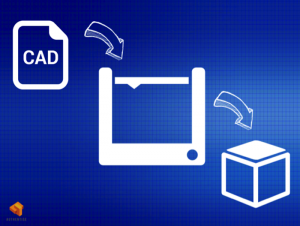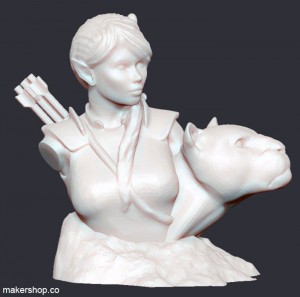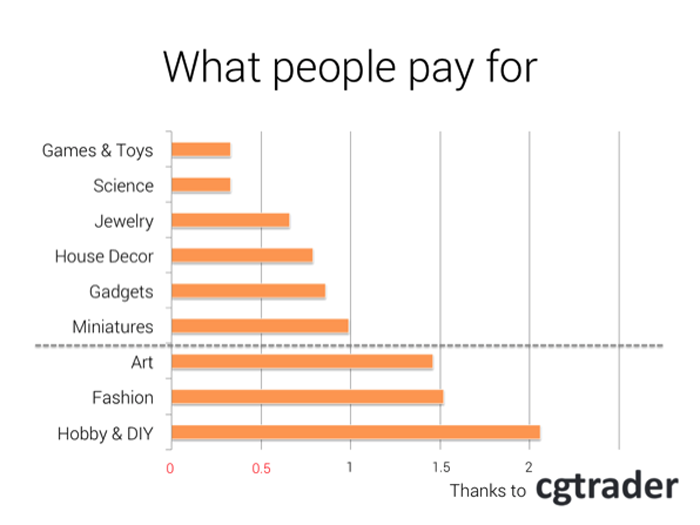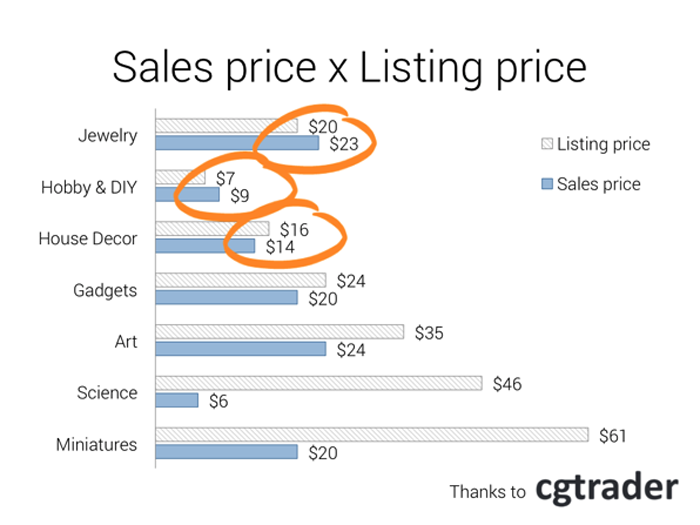Last April, we launched the Authentise design stream to provide designers and content owners a legal and secure pipe to sell 3D designs to 3D printer owners. In almost a year working on it, we learned that intellectual property protection is not only about file sharing, but also about design integrity and market positioning. We also learned that, by using a pay-per-print model, prices can drop by 80 to 90% — which drives sales up and gets more premium content to the market, and makes new use cases available. More prints mean more printers and more material, leading to lower overall prices. That benefits the whole 3D printing ecosystem.
In this post, we want to share with 3D designers what we observed working with top design marketplaces like CG Trader, makershop, Pinshape, and another dozen websites all over the world. We’ve had the chance to analyze and monitor the impact that different sales and pricing models have had on market demand. Here is what we found out about what people want to print, what people want to pay for, and what triggers a design sale.
Free vs. Paid
More often than not, when I’m talking about Authentise, I hear that “people don’t want to pay for models for 3D printing”. But to me, saying that people don’t want to pay for designs is like saying that people will not pay for music or books. I think it would be more accurate to say some people pay for music and for books, and some people don’t. But I can absolutely see how one can arrive at this conclusion.
Let’s say that you’re looking for a printable iPhone 6 case: nearly 80% of the models indexed by Yeggi are free. The availability of free models certainly helps shape the price perception of 3D printable designs. When something is widely available for free it becomes difficult to sell it, and many designers wonder “how can you market an original design on this landscape?”
Price perception on 3D printing
A good portion of price perception is shaped by branding and marketing, but it also has to do with the impression of how much a product costs in terms of its production.
I have an example to help illustrate this point. When digital books first came to the market, most people did not want to pay for them, since there was no physical product being manufactured. When you price a physical product, you have to take into account its development, manufacturing, shipping, storing, and taxes. For a digital product, however, you don’t need storing and shipping, but you do need everything else. With time, we learned to separate the costs of the authors, editors, and publishers from the production cost and started paying for the digital product.

The top 2 things to consider when communicating the value of your design work to the general public, regardless of how knowledgeable they are on design or 3D printing, should be:
- Complexity and Originality
In 3D printing, complexity is free. Printing an ornate and complicated shape is not more costly than printing a simple block. Objects that could never previously be manufactured with traditional methods are now able to be easily printed.
If you, as a designer, can create something that clearly takes advantage of this fundamental 3D printing principle, it’s likely that your target market will perceive the value of your work hour. 3D printing is a powerful weapon of originality and can be used creatively to demonstrate a huge degree of differentiation. Make sure what you’re presenting is something that can not be found anywhere else and can not be manufactured with any other process.
- Complexity and Skill

What sells?
But what actually sells? What do people want to buy and print?
To understand the 3D printable design market opportunity, we need to first take a look at what people search for, and what they want to print — regardless of whether they are willing to pay.
What you see below is the top 20 searched from Yeggi, one of our favorite CAD search engines.
If you rule out trademarked content and things people should not be printing, you still have a lot of options to consider.
Now, let’s discuss what people are already paying for. This is a graph plotted with information kindly provided by CG Trader, one of our partners.
To make a clear distinction: consider the “Games & Toys” category to be chess sets, dices for role playing games, while a good example of “Miniatures” would be figurines. The category of “Hobby & DIY” includes parts for robots and quadcopters, and “Gadgets” would be phone cases and camera mounts.
What you see here is how many average sales a category has, compared to the marketplace average. This is how it works: The 1 point represents the marketplace overall average sales. The horizontal bars mark how the category of average sales relates to the marketplace overall. It means that every category ranking higher than the 1 point mark is a much better market opportunity than the average. “Hobby & DIY”, for example, sells twice as much as the marketplace average.
Pricing your models
With a better understanding on what influences price perception on 3D printable models and what people want to buy, it will be easier to price your own models; however, it’s important to also account for one more thing: mental price barriers.
If two price tags are below a certain barrier, the client will probably have a similar reaction to both. Common online commerce price barriers are $2, $5, $10, $20, $50 and $100.
For instance, $14.50 and $19.70 are both near the $20 barrier, so the prices would trigger a very similar reaction in a consumer’s mind. The same is probably also true for the price points of $28.90 and $39.90.
Here’s an example of how important it is to price your models within the price barrier of your category, which is also plotted with data from CG Trader:
“Jewelry” and “Hobby” are both categories above average sales and, not coincidentally, are priced and listed near the same $20 dollar barrier. But the category of “House Decor” is under average in sales and only slightly overpriced. Maybe a couple of dollars here might be able to push sales up? Probably. On the category of “Art”, where the difference between listing price and sales price is around $10, there should be great deals to be made since it is already a high selling category. Could it be a discrepancy between the quality expected and the price tag?
Always keep in mind the complexity of the design. Customers are looking for a package of attractive price and quality. Models with the price range of $30-$40 sell the most often, but if you are selling simple 3D models, your strategy may be to price them below $10 to reach 1.5 times more sales than if priced in the $10-$20 price range.
Selling more
After you have done your pricing homework, there are three more things you can do to ensure more sales:
- Build portfolio
CG Trader’s data suggests that designers with 100 to 150 models sell 1.7 times more often than designers with 1 to 50 models. Even if the designer is able to grow his or her number of models overtime, the results are still not the same than designers that start with a larger portfolio. We are not sure if this is because a higher number of models might indicate a superior experience and quality of work, but, apparently, if you are able to offer over 100 models for sale, you will be maximizing your chances for success.
- Preview images
How many preview images do you usually upload? 5 images? 10 perhaps?
According to CG Trader, models with 5 to 9 preview images sell 3 times more often than models with up to 4 preview images. If you are willing to put in real effort, models with 35 to 39 preview images sell 10 times more.
- Let customers test-drive your work
Designers that offer free models in their portfolio are likely to have 60% more sales. It is easy to understand that, before a big investment, customers would like to print something free of charge, to ensure they will be paying for quality work.
If you are not comfortable with giving away your file, even if it is offered for free, you can also use Authentise design stream to let your clients print this test drive, and take the opportunity to grab feedback about the prints to keep improving your work.
The learning cycle never ends. We are looking forward to one more year of design sales to discover what has changed and what has remained static. This is a very early market that is changing everyday as new technologies get released and popularized;even small changes can have a great impact on awareness and adoption.
We couldn’t be more excited to see design sales grow even more in 2015. Happy holidays!







